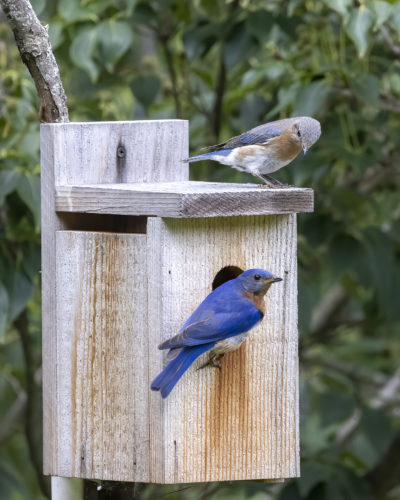Participant Photos
upload and share photos
Photo Submission
Submitted By
Paul Schmitt
Big Flats, NY, USA
Description
This is our first year with a bluebird house. We are in a suburban setting with no Tree Swallows to compete with bluebirds. A pair of Eastern Bluebirds has been nesting each spring at the home across the street so we added the bird house and put a cup feeders with meal worms. After the pair’s first brood fledged, the adults selected our birdhouse for the second brood. Sometime around July 21, I repeatedly saw what I believe is juvenile male perching near to adult, and both visiting nest box as seen it first image. I am sure female was in the box. (There are four chicks.) On August 19, I observed the juvenile male enter box with grasshopper (?) and minute later exit. Note in second image that the wings have male blue but shoulders are still dark. Isn’t this clearly a juvie? Today is 8/20. I observed three drab birds on the next box at the same time. Granted, one could be adult female but at least two are juveniles. I frequently see two of these drab birds at morning feeding frenzy with one entering box, and a second waiting. Are helpers all that rare and we are just lucky?
Category
Species
Continue Browsing
Tag:












Hi Paul,
In the first photo, the bird on top of the box is an adult female. Females are not always drab; they can be bright. In the second photo, that is a juvenile male on the box.
Juvenile helping is uncommon in Eastern Bluebirds but does occur. The thing to watch for would be a confirmed juvenile entering a box with food and (possibly) leaving with a fecal sac. Perching on the box, near the adults, etc. is not necessarily evidence of helping because they could just be trying to get a free meal from their parents. Some juveniles even go so far as to enter the box where the second brood is being fed, and try to intercept a meal!
Careful observation and photos/videos will be key to identifying this rare behavior. Enjoy learning about your new pair’s behaviors and patterns.